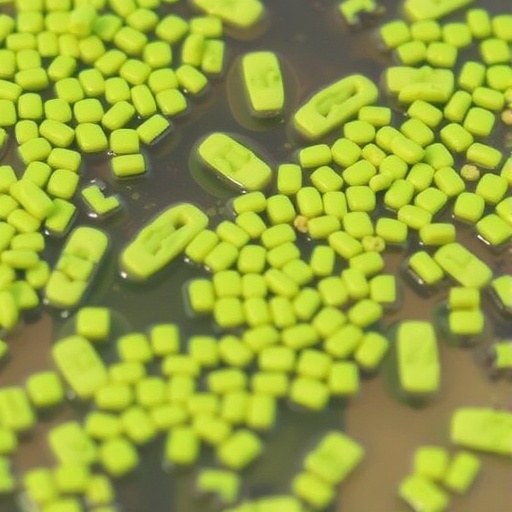In an extensive investigation of the aquatic ecosystems of the Godavari River system, researchers have meticulously cataloged the epiphytic algal flora present on various aquatic macrophytes. This complex interplay between algae and macrophytes shows how diverse organisms contribute to ecosystem health and resilience. A vast majority of aquatic plants host epiphytic algae on their surfaces, which plays critical roles in nutrient cycling, primary production, and biofiltration. The phenomenon of epiphytism is not merely incidental; rather, it forms a dynamic biological community teeming with life, directly influencing the health of aquatic ecosystems.
The study led by Khapare, Lokhande, and Andhale meticulously explored the diversity of epiphytic algae across several sites within the Godavari river basin. Researchers deployed various methods, including observational surveys and sampling techniques, to gather data on algal species richness and abundance. This methodology allowed for comprehensive insights into algal distribution across different types of aquatic macrophytes. The results indicate an intricate relationship between the types of macrophytes present and the diversity of algal species they support.
Importantly, the study highlights how environmental factors such as water quality, nutrient levels, and hydrological parameters greatly influence epiphytic algal communities. The findings underscore the significance of maintaining optimal environmental conditions as a crucial factor for preserving biodiversity within riverine ecosystems. The degradation of water quality due to anthropogenic activities threatens these intricate relationships, potentially destabilizing the entire aquatic ecosystem.
Data gathered from the Godavari River demonstrated that various macrophyte species such as Hydrilla verticillata, Eichhornia crassipes, and Vallisneria spiralis serve as crucial habitats for algal proliferations. These plants not only provide a stable surface for algal colonization but also offer shading, which can moderate the microenvironment of algae by reducing light penetration. As such, they play an essential role in both the ecological sustainability of aquatic habitats and the overall health of the river ecosystem.
The interactions between epiphytic algae and macrophytes are multifaceted. Algae can enhance the growth of their host plants through nutrient recycling, while the plants afford the algae a physical substrate for attachment. This mutually beneficial relationship is critical, especially in shallow waters where light availability can vary significantly with changing seasons. It is fascinating to consider how this dynamic can shift with changes in environmental conditions—overgrowth by algae may inhibit plant growth under certain circumstances, illustrating the complexity of these ecological interactions.
To quantify algal diversity, the researchers employed a combination of morphological and molecular techniques, leading to the identification of various algal taxa including diatoms, green algae, and cyanobacteria. Their results revealed a higher diversity of epiphytic algae than previously documented in the region, suggesting that the river system exhibits significant algal resilience. The revelation of the hidden diversity within these algal communities empowers ecologists and conservationists to better understand the functioning of these aquatic ecosystems.
One notable finding of the research is the robust response of algal communities to fluctuating nutrient levels, particularly nitrogen and phosphorus concentrations. These nutrients are vital for growth, yet excessive nutrient inputs can lead to algal blooms, which produce harmful effects on water quality and aquatic life. The study emphasizes the importance of monitoring nutrient levels and controlling pollutant runoff in order to maintain the health of both algal and macrophyte populations along the Godavari river.
Moreover, the research reflects broader implications for climate change impacts on freshwater ecosystems. As global temperatures rise, and precipitation patterns shift, the delicate balance that supports these epiphytic communities can be disrupted. Understanding the interactions between abiotic and biotic factors in these ecosystems will be essential for predicting the future dynamics of riverine habitats under climate change scenarios. It is imperative that measures are taken to protect and enhance these environments to mitigate adverse effects stemming from human-induced changes.
Another interesting aspect of the study is the role of epiphytic algae as bioindicators of environmental health. Their sensitivity to changes in water quality makes them valuable for monitoring ecological status and trends in freshwater systems. Tools such as bioassessments, which leverage algal community structure, can aid in the development of effective conservation strategies and policy frameworks aimed at protecting these vital ecosystems. The insights garnered from the Godavari river serve as a reference point for other aquatic systems facing similar environmental pressures.
The research also opens up opportunities for further inquiries into the complex relationships within aquatic ecosystems. Future studies could explore the role of other biotic factors, such as the influence of grazers or competition among algal species, in shaping these communities. By delving deeper into the subtle interactions between species, scientists can uncover critical insights that contribute to our understanding of aquatic ecology.
Ultimately, this groundbreaking study enriches not only the scientific literature concerning algal ecology but also reinforces the necessity for sustainable management of freshwater resources. Collaborative efforts between researchers, policymakers, and local communities will be critical in fostering resilient river ecosystems capable of withstanding the pressures of climate change and human activity.
In conclusion, the exploration of epiphytic algal flora on aquatic macrophytes of the Godavari River system represents an essential stride towards comprehending the intricacies of freshwater ecosystems. Such research exemplifies the need for a multi-faceted approach in studying biodiversity and environmental interactions. By amplifying our understanding of these intricate relationships, we secure a future where ecological restoration and conservation can thrive.
Subject of Research: Epiphytic algal flora on aquatic macrophytes in the Godavari river system
Article Title: Epiphytic algal flora on aquatic macrophytes of the Godavari river system diversity interactions and environmental influences.
Article References:
khapare, P., Lokhande, S. & Andhale, S. Epiphytic algal flora on aquatic macrophytes of the Godavari river system diversity interactions and environmental influences. Discov. Plants 2, 337 (2025). https://doi.org/10.1007/s44372-025-00418-7
Image Credits: AI Generated
DOI: https://doi.org/10.1007/s44372-025-00418-7
Keywords: Epiphytic algae, aquatic macrophytes, Godavari river, ecological interactions, environmental influences.




